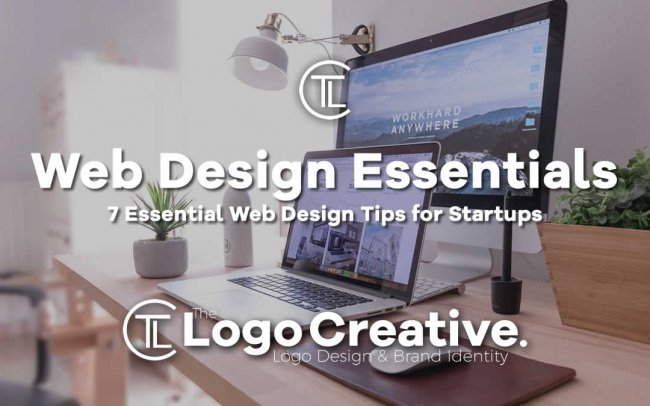In this article, we share 7 Essential Web Design Tips for Startups.
Having a website to help market your business is a must in this day and age and as Bill Gates, Microsoft Founder, once quoted, “If your business is not on the internet, then your business will be out of business.” Let’s jump in to these 7 Essential Web Design Tips for Startup websites.
According to research by Adobe, 59% of people would rather browse through beautifully designed websites than plain and ordinary ones.
A study reveals that a staggering 92% of small business owners believe that having a website is the most effective digital marketing strategy out there.
Clearly, web design plays a major role in the success of any business, so let’s take a look at how you can utilize its full potential.
Table of Contents
Development for Mobile
As mobile technology evolves, an increasing number of people around the world have access to the internet through their mobile devices. As a result, it’s extremely important for your company to develop a website that is mobile friendly and adaptable for various screen sizes.
UX statistics gathered from industry experts such as QuickSprout and Google show that 52% of users are less likely to engage with a company if they are encountered with a negative mobile experience.
To keep your site mobile-friendly, follow these tips:
- Don’t use dual websites. In the past, web developers would create a separate website for mobile devices. This is an outdated practice and Google advises against it. If you want improved search traffic, use one URL for both your desktop and responsive websites.
- Use structured data. You should use the same structured data on your mobile website as you do on the desktop version. With mobile-first indexing, Google will only go through the structured data on mobile and skip the desktop version.
- Avoid Flash. Flash drains mobile resources, it sucks battery power and doesn’t work on mobile devices. Furthermore, Flash has security issues and you are advised to avoid using it. But remember to make your Javascript, image and CSS files available to Google through the Google Search Console.
- Pay attention to button size and fonts. Use a minimum font size of 14px for mobile and 11 Points for IOS. Make sure your buttons are at least 44PX by 44PX. Stick with a single typeface and use whitespace for readability. Tighten the lead and favor left side alignment.
- Use Hi-Res Images. Use images with double the resolution than you would on desktop. This makes for a more enjoyable mobile user experience.
- Avoid pop-ups. Users dislike pop-ups, Google doesn’t appreciate them either while some argue that pop-ups are one of the most hated advertising techniques
Make Your Design Unique
Since there are so many websites available on the internet, it’s important to create a design that is eye-catching and unique in order to stand out from your competition.
According to research, 75% of potential customers often make judgments on a company’s credibility based on the overall aesthetics of their website.
Do your research and find the right colors and elements that speak directly to your customers. Prior to the official launch of your website, you can test several iterations and perhaps perform usability research to see which version of the website is more preferred by the target audience.
Through continuous testing and user experience research, you will be able to design a website that speaks volumes to your audience.
Have a Clear Call to Action (CTA)
Guide your users by having a clear call to action such as a button or direct link. Whether it’s a sale or other forms of promotion, make sure your users can find information quickly and easily on your website.
Research shows that 86% of visitors want to see information relating to products and services. In addition, make sure to include important information that your users might want to see such as an “about us” page and contact information.
Your CTA has to be clear and concise so start it with the desired action. For example, if you are promoting a whitepaper, start the CTA with “download” or “subscribe”.
Try to use words that will evoke emotions in users and provoke enthusiasm. Give your audience a good reason to perform an action, so try to stand out and offer a unique selling point.
Always be aware of the devices on which the CTA will appear and don’t be afraid to get creative.
Improve Navigation
Don’t approach the design process without proper planning. Think about the sections your website needs and create a sitemap as a part of your navigation planning.
If you are designing a normal business website using themes such as the ones mentioned here, don’t reinvent the wheel.
Rather, use web conventions (and built-in theme menus, such as a mega menu) unless you have a better solution. Furthermore, don’t forget to make your navigation responsive and to link the logo to your homepage.
Also, implement sticky navigation so that it stays fixed as the user scrolls through the site.
There is nothing worse than having navigation that is confusing and difficult to utilize. Users that experience bad navigation might not want to return to your website; therefore, make sure to use the right colors and text in order for your navigation to stand out.
Remember, there’s a lot of competition online so you have to use user-friendly language so that your navigation seems logical and makes for a seamless UX.
Optimize the Content for Search Engines
We live in a reality in which people use Google to find Bing. And it is a well-known fact that Google prefers well-optimized content. If you optimize your content correctly, search engines will be able to put it in front of the right users.
Google wants to answer the searcher’s intent as precisely as possible so you have to create and optimize content in a logical way.
Use the proper keywords and links so users can find your website through Google, Yahoo or Bing. Think about the terms that your users might use to search for your products and make sure to include them on your website.
Use different styles of text such as headline, body, subheadings and body text. Following good search engine optimization guidelines will help your page rank higher on Google and will ultimately drive more traffic to your website.
Include Relevant Content
Ever since Bill Gates coined the phrase “content is king”, there has been more emphasis on creating better content that resonates with the target audience.
Whether your content contains images, videos or text, make sure that it’s relevant to your business.
Content marketing can be a difficult task because according to CMI, 56% of B2C marketers say that “producing engaging content” is one of the top challenges they face.
You need to create content that reflects your brand and conveys the right messages. While content is king, context is the emperor because today, it has become extremely important to fit your content into the right context for the user to find it more easily.
The last thing you want to do is misrepresent yourself through content and end up having huge bounce rates and loss of revenue. So if you are selling software, don’t talk about some abstract notions, rather explain exactly what the software can do.
Don’t ask people to “join you on a mission” or “be a part of something great”. Rather, just sell them software since that’s what they came for.
Keep Improving the User Experience
When designing a website, make sure to think about your audience and what problems they might face when accessing it. One of the common problems is language.
Try to translate your website to the native languages of the majority of your users.
On another note, an Ironpaper survey shows that 40% of people get frustrated if a website takes more than 3 seconds to load. You don’t want to lose clients over something that is easily solvable.
You can improve the user experience by having sections on your website for general questions and answers aimed at beginners and product pages for pros.
Try using a tool like Hotjar for monitoring user activity on your website to get insight into their problems with UX.
Implement links for social networks on the website so users can more easily understand your brand. Be careful not to overwhelm your users with data entry.
Instead, utilize a “drip” methodology where you don’t ask users to enter all data in one day, but over a longer period of time.
Design Your Way to Success
In conclusion, when designing a website for your startup, make sure to create a well-designed user experience with easy navigation and quality content.
By creating content and design that speaks to your customers, you will be able to increase sales and maintain long-lasting client relationships.
Many customers often tell their circle of friends about their positive experience with a brand; therefore, focus on building on the relationship that you have.
Know that your customers’ time is valuable; therefore, make it easy for them to find important information on your website.
Redesign Your Website
It’s important to redesign your website to realize your online presence and attain your goals. Do you want to reach out to more potential customers?
You probably already have a strong customer base, and you just need exposure to your new products and services.
Regardless of the reason, redesigning your website is like recreating your home to become more beautiful, functional, and comfortable.
Here are some tips for when redesigning your website:
- Analyze Your “old” Website: What’s working on your old website, and what’s not? Identify specific problems, such as frequently abandoned shopping carts. Use Google Analytics to study traffic patterns, know if you have a high bounce rate (number of users leaving your website right away once clicked your URL) and which pages receive the fastest and most frequent bounces.
- Add Strong Visual Elements: Because people respond better to illustrations, videos, and images than plain text, adding eye-catching features and visual elements is highly recommended. For instance, you can use custom images rather than stock photography.
- Personalize Your Website: Personalizing your website according to your brand, helps you show off your personality. So, it’s high time to think about the different ways you can communicate with your target audience, like your blog’s voice. Use imagery, fonts, and colors that reflect your identity and write in a consistent voice to avoid confusion.
- Use Contrasting Colors: Make your website design pop up using contrasting colors, highlighting the key areas you want your visitors to notice using a color that is not found elsewhere on the web page.
- Build a Blog: For startups, it’s important to build a blog as early as now because content marketing is an excellent way to drive website traffic. Make sure to write blogs consistently about different topics that can help solve the problems of your target audience and attract search traffic, likes, and social media shares.
I hope these 7 Essential Web Design Tips for Startups have been helpful, and be sure to leave your comments below.
Useful Links & Great Deals
- The Equipment We Use & Recommend
- Quality Design Bundles
- Get 2 Months of Free Skillshare
- Get an Exclusive 20% off Logo Package Express
- Learn Logo Design Online
 Author bio
Author bio
Hailing from Los Angeles, Larry Reed is an experienced tech blogger. He enjoys writing on web design, marketing, and business topics.



